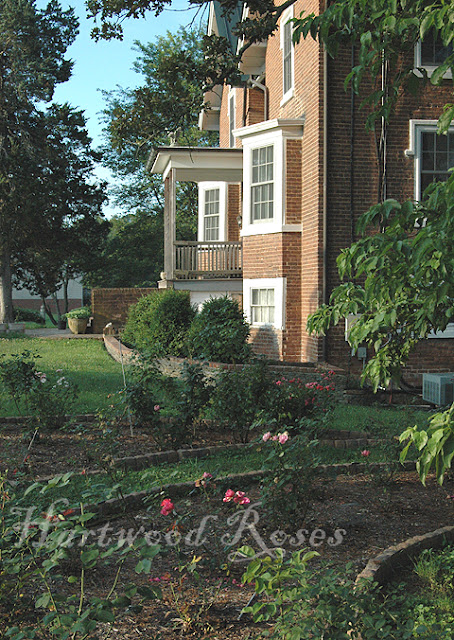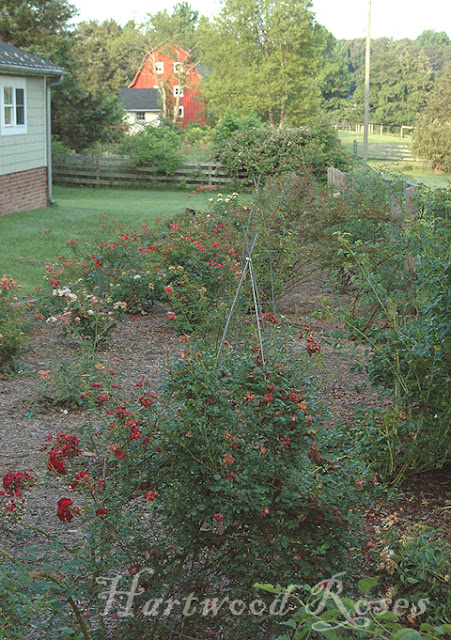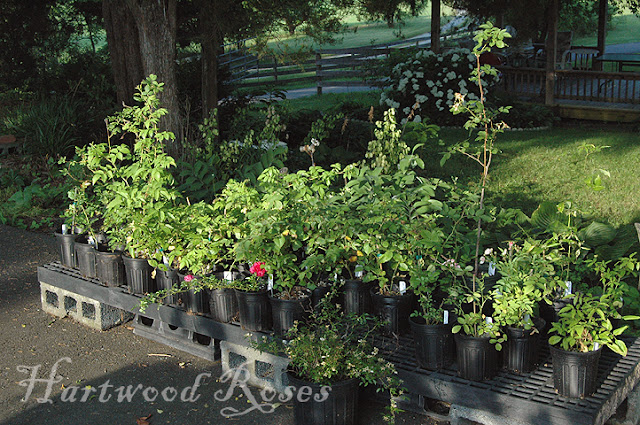I open my rose garden to the public for drop-in visits on one day in the spring. Open Garden for this year was last Sunday, June 7. My goal is to try to schedule this date to coincide with overwhelming full bloom ... haven't nailed this quite yet, but there is still always a LOT to see ... no matter if the date is too early or too late. This year, it was about a week late.
There is so much here to experience that, years ago, we decided that it would be helpful for visitors to have a map of the property and gardens. My talented artist husband sketched this one afternoon, and we update it whenever something changes.
Let's follow the map's legend and take a long, leisurely tour of the property, structures, and gardens at Hartwood Manor ... emphasis on the "long" part of this tour, because this is a long post. Garden photos in this post were taken this morning, June 12, 2015. The roses, in general, are mostly past peak and flowers have dried up in our summer heat from the past few days. There is still a lot to look at, though, as you will see.
1. Front Fence Border.
This was the first rose garden at Hartwood Roses, designed and planted in 2007. This area was formerly a huge overgrown feral Forsythia hedge. It contains a collection of Noisette, Hybrid Perpetual, Bourbon, Hybrid Musk, China, and Tea roses. This garden was renovated in 2015, to make space for roses from the Leonie Bell collection at Tufton Farm.
'Dr. W. Van Fleet', planted so that it's the first rose I see every time I pull into the driveway.
No flowers left on 'Moonlight' and 'Shailer's Provence' ... a beautiful combination two weeks ago.
Tiny new plant of "Single Pink China" from the Tufton Collection is continuing to grow and flower.
Newly planted "Cemetery Musk Seedling" is doing great.
2. Hybrid Tea Garden.
Four geometric garden beds, cut into the turf and edged in brick, in the style of an early formal rose garden. This garden contains an assortment of 80 Hybrid Tea and Floribunda roses, mostly from the late 19th and early 20th century.
North side of the Hybrid Tea Garden.
Beautiful fiery orange bud on 'Maria Stern'
Second flush of bloom on 'Poulsen's Pearl'
I have yet to accurately capture Hadley's deep magenta red.
'Peace' was one of my grandmother's favorite roses.
3. Van Fleet Fence.
This garden along one side of the concrete cannonball fence beside our circular driveway is planted with once-blooming Hybrid Wichurana ramblers developed in the early 20th century by my favorite hybridizer, Dr. Walter Van Fleet of Beltsville, Maryland.
The star of this area was 'Glenn Dale', attracting attention for his beautiful form and foliage ... even without any flowers.
4. Hartwood Manor.
A brick Gothic-Revival farmhouse. The original portion of the house dates from 1848, with a major addition that was added in 1967. We have owned the property since 2002.
Unstaged photo from this morning. Our family loves our Jeeps!
5. Greenhouse.
Built in 2010, the greenhouse and its lean-to addition were designed to make use of salvaged and reclaimed materials. Windows from two 1960s houses, skylights from a builder liquidation, timbers from a dismantled retaining wall, cast iron columns, and other materials were collected over the years.
6. The Shack.
This little building was used as a workshop and for storage by previous owners. We are renovating it to eventually be used as a studio.
7. Detached Carriage-House Garage.
Designed and built in 2005, the garage is sited in the exact location of a 20th century equipment shed/goat barn that was deteriorated beyond repair.
8. The Arcade.
A large pergola, nine feet tall and 54 feet long, planted with ten repeat-flowering climbers, trained in a pillar style.
Most people who were here on Sunday took their picture in front of 'White Cap'
These flowers were damaged by the heat yesterday, but the color of 'Pink Pillar' is still amazing.
9. The Rambler Fence.
The roses planted in this garden are Hybrid Wichurana ramblers introduced by Barbier and Company and other hybridizers in France in the early 20th century. Tea roses are planted to fill in the space in front of the ramblers.
The Rambler Fence is in desperate need of a makeover. Doesn't stop 'Ghislaine de Feligonde' from continuing to pump out its beautiful, delicate flowers.
10. The Rose Field.
Three hundred roses were originally planted in this garden in 2008, which is 150 feet long and 75 feet wide, with gravel paths between the planting beds and steel arches over a central aisle. A little bit of neglect a few years ago allowed weeds to get a foothold, and now this garden needs a major overhaul. [even in its heinous state, there is beauty along the accessible edges of the Rose Field.]
"Arcata Pink Globe" taking over this corner of the fence.
Mostly finished blooming for this year, though there were still a few flowers to admire.
Unidentified blue Clematis, making a great contrast against the rustic board fence.
"Peggy Martin" draped on the fence, flowering her little brains out.
11. The Cottage.
Mid-20th century concrete block building that has been used as a milk house, pump house, and a tack shed. We use it for storage.
Oil painting of our barn, the cottage, and rose gardens, by our friend Ed King.
12. The Barn.
Probably built in the early 20th century as a dairy and cattle barn. Brought back from the brink of ruin and restored in 2007. [There is a link on the sidebar to a very long post that I published a few years ago, that details the barn's damaged condition and work that was necessary to restore it.]
13. English Garden.
This garden contains a growing collection of found Noisette roses and about thirty David Austin English roses.
'Morning Mist' was one of the stars of Open Garden.
Early in the morning, when this photo was taken, flowers were just starting to reopen for the day.
found Noisette rose, probably the pollen parent for my "Lilian Austin Noisette Seedling"
"Seedling" has another big bud, which will probably open next week.
'Queen Nefertiti' is a little known David Austin rose that performs very well in my garden.
My other seedling, from an open-pollinated hip on 'Peace' is a beautiful thing!
14. Miniature Garden.
The newest garden on the property, designed in 2013, is eleven feet wide and 150 feet long. Contains a collection of over one hundred historic miniature roses, miniature China roses, miniature climbing roses, and classic Floribunda, Hybrid Tea, and Shrub roses. Once-blooming large-flowered rambler roses are trained to wire on the fence.
These flowers on 'Paul Ecke, Jr.' are a bit past peak, but they are still a great representation of this rose's insane burnt red color.
You already know how much I love singles ... I love single Hybrid Tea roses most of all!
Red miniature 'My Valentine' never seems to be without flowers.
The deep color of 'Black Ice' is a beacon in the garden.
15. Nursery Sales Area.
The driveway beside the house is the current home of the roses for sale (as available).
Roses for sale during Open Garden were arranged on a makeshift bench in the shady driveway.
"Hanover Excelsa" is still pumping out the flowers.
16. Pavilion.
Surrounded by shade garden plants, including hosta, hellebore, hydrangea, Solomon Seal, and Japanese maple.
Refreshments during Open Garden were set up in the Pavilion, where visitors sat and enjoyed the breezes and the view.
Open Garden on Sunday was VERY well attended. The first car-full of visitors arrived at the stroke of 10:00 when we opened, and traffic was steady all day. We had printed out 50 walking tour maps, giving one to each group/carload of people, and had only 20 maps left when we closed at 3:00. I tried to talk to everyone that I could, answering questions and showing people around. My husband handled parking, and gave out maps and instructions.
Some of the visitors were friends and other people I know, but most were strangers who found out about the event somehow. (I had it listed here and on the Hartwood Roses Facebook page. The local tourism folks picked it up and put it on their site and in their monthly email blast, and the newspaper picked it up from somewhere.) All of the visitors that my husband and I talked to were happy to be here, couldn't believe that this is our private house and that we open the garden like we do ... and a few were amazed that we don't charge admission.
My philosophy is simple. I garden because it makes me happy. I open my garden to visitors because I want to share it with others to make THEM happy. On Sunday, we had families with children, families with grandparents, young couples, singles, and every other assortment of groups come through here. Some were surprised to be treated so hospitably ... hey, it's the only way that I know how to do things, Folks.
A garden club friend of mine, who had never visited here before, paid me the ultimate compliment without knowing it. He said, "I always thought that rose growers are an obsessive sort, but you're not like that at all."
Thanks, Ed ... I'm glad you noticed.



























































































